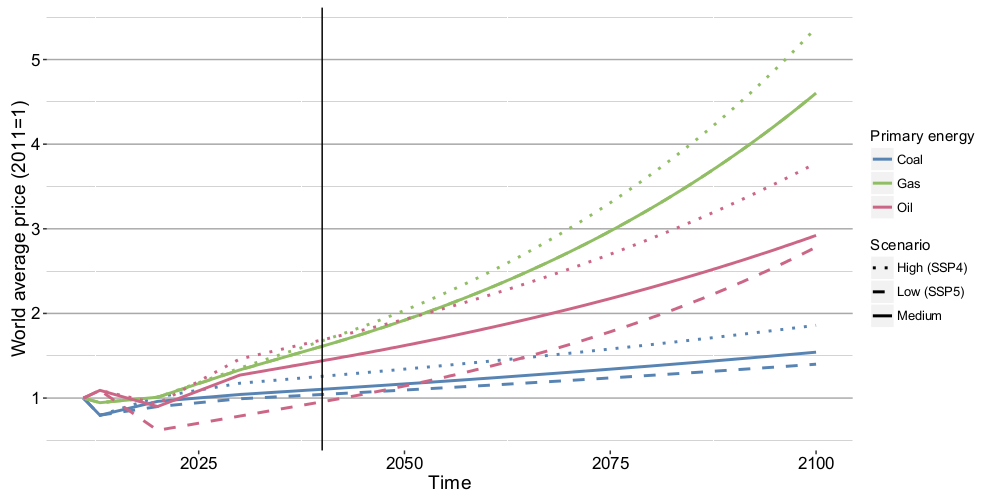MIRAGE-e Baseline #
MIRAGE-e’s baseline is basically an implementation of MaGE model macroeconomic projections. The following variables are used from MaGE’s output, the EconMap database:
- GDP projections
- Population
- Skilled and unskilled labor
- Savings rate and current account
- Energy productivity
In addition to these variables from MaGE/EconMap, the following assumptions are also included in the baseline:
- Fossil energy prices trajectories are calibrated after International Energy Agency projections
- Sector decomposition of TFP growth between agriculture, manufacturing ans services
General presentation of the baseline design #

By default, the baseline exercise is made of two sets of model simulations:
- Step 1 : Only projections in macroeconomic determinants. It is also
possible to include in this step other assumptions, but this
requires that such assumptions are not likely to significantly
impact GDP growth.
- This is the “baseline” strico-sensu, as it is common in most CGE models
- In this step, the GDP trajectory is imposed to the model in order to calibrate the trajectory of TFP growth
- Step 2 : Other assumptions are implemented in the second step (e.g.
large free trade agreements, Paris agreement)
- This step takes the productivity calibrated in step 1 as given, and let GDP be endogenous.
- This allows to account for the effect of baseline assumptions on GDP and energy prices
GDP projections #
TFP in MIRAGE-e #
TFP in MIRAGE-e consists in a region-specific TFP, $TFP_{r,t}$ and a sector-specific component $TFPJ_{j,r,t}$. Both concern only energy and the five factors (capital, skilled labor, unskilled labor - embodied in the $VAQL_{j,r,t}$ bundle - as well as land and natural resources) of the production function:
Calibration in the baseline exercise #
MIRAGE-e baseline (in Step 1) exercise starts from the following assumptions in order to calibrate a baseline trajectory for TFP:
- MaGE GDP growth rates $g^{GDP}_{r,t}$
- Exogenous agricultural TFP $TFP^{Agri}_{j,r,t}$
- Constant 2 p.p. growth difference between manufacturing and services $\Delta g^{TFP}_j$
This translates in the following relations:
Population and labor #
Population and labor by educational level are simply following the growth rate from EconMap:
Savings rate and current account #
Current Account in MIRAGE-e #
Current account (im)balances $CABal_{s,t}$ are used in the macroeconomic closure equation:
Calibration of savings rate and current account #
Savings rate #
Savings rate follows EconMap projections $Savings_{r,t}$ additively:
Current account #
Current account imbalances evolve additively:
while $\delta CABal_{r,t}$ is calibrated after EconMap’s $CurrentAccount_{r,t}$, but keeping world current account balance:
Energy productivity #
<alert type=“info” icon=“glyphicon glyphicon-asterisk”>This feature is only available if energy in value added is toggled on</alert>
Energy productivity in MIRAGE-e #
In MIRAGE-e, total energy consumption by each sector $ETOT_{j,r,t}$ is subject to energy-specific technological improvement $EE_{j,r,t}$:
$EE_{j,r,t}$ is applied to every sector, except for non-electricity energy producing sectors (coal, oil, gas, petroleum and coal products), whose energy productivity is constant.
Baseline calibration #
This energy-specific technological improvement is calibrated in the baseline after MaGE’s projected energy productivity $B_{r,t}$. However, three things differ between $B_{r,t}$ and $EE_{j,r,t}$:
- In MIRAGE notations, share coefficients and productivity improvement appear in CES functions at the power of $1/\sigma$ whereas in MaGE, $B_{r,t}$ appears at the power of $(\sigma-1)/\sigma$. We therefore introduce $EProd_{r,t}$:
- $B_{r,t}$ is labelled in dollars per ton of oil equivalent, whereas $EE_{j,r,t}$ and $EProd_{r,t}$ are calibrated at 1
- In MaGE’s production function, $B_{r,t}$ (as well as capital-labor productivity $A_{r,t}$) include an hypothetical TFP, whereas in MIRAGE, $EE_{j,r,t}$ comes in addition to the TFP level $TFP_{r,t}TFPJ_{j,r,t}$
Fossil fuels energy prices #

Natural resources in MIRAGE-e #
In MIRAGE-e, a sector-specific reserve factor $RESV_j,t$ is introduced to scale natural resources globally for each primary fossil energy (coal, oil gas)[(the equation is provided here for perfect competition only)]:
Calibration of natural resources in the baseline #
During the baseline exercise, the reserve factor is set endogenous, while world price defined as:
is kept exogenous: